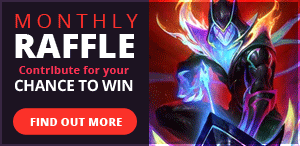Not Updated For Current Season
This guide has not yet been updated for the current season. Please keep this in mind while reading. You can see the most recently updated guides on the browse guides page
x
x
Did this guide help you? If so please give them a vote or leave a comment.
You can even win prizes by doing so!
Vote
Comment
I liked this Guide

I didn't like this Guide

 Thank You!
Thank You!
Your votes and comments encourage our guide authors to continue
creating helpful guides for the League of Legends community.
Spells:

Clairvoyance

Flash
Ability Order

Tailwind (PASSIVE)
Janna Passive Ability
Introduction

You should treat Janna as a mobile gank deterrent. Every one of her skills is effective at stalling enemy champions and providing powerful cover for your teammates. Spell placement and timing is very important to skilled Janna play; she is far more nuanced than more straightforward "babysitter" support champions like
Finally, Janna's high mobility and modest item dependency makes her an ideal champion to track enemy movement. A good Janna player should ward everywhere, and expect to devote a significant chunk of their already-meager gold intake to wards and
Janna is the team's behind-the-scenes orchestrator. What she lacks in champion kills, she typically makes up for in impressive assist numbers and overall ***-saving. Played well, Janna won't carry a team to victory in the traditional sense, but she will act as the team's central nervous system, route coordinator, and combat tide-turner. Shrewd Janna play wins games.
This guide describes how to play Janna on Summoner's Rift. She is a comparatively poor pick on Twisted Treeline (meta emphasizes steady full-team ambushes and tanky, health-stacked melee champions) and Crystal Scar (meta emphasizes heavy-damage champions, and deemphasizes support roles, high sustainability, and farming dynamics).
Special thanks to Zirun and s0ma for their own excellent Janna guides, which have obviously and heavily influenced my own Janna tactics. Also, props to JHOIJHOI's MOBAFire guide tutorial for helpful coding advice and layout templates.
This guide is current as of the November 29, 2011 patch (League of Legends v1.0.0.130 -- Volibear patch).
Janna unquestionably benefits from scaling mana regen seals (Clarity) and either scaling or flat cooldown reduction glyphs (Celerity/Focus). Newer players might want to start with flat health quintessences (Fortitude) for the added durability, though I recommend movement speed quintessences (Swiftness) once you learn to exercise a proper level of caution. Marks are a bit trickier, as nothing stands out as an absolute optimal choice for Janna; I personally use flat armor marks (Resilience), but you also can't really go wrong with flat magic resist marks (Warding).
In serious play,
You should prioritize

Janna's items should emphasize gold generation, cooldown reduction, movement speed, mana regen, durability (i.e. armor/magic resist/health/health regen), and late-game team auras. Janna should not devote significant resources to ability power, as she is not a powerful damage-dealer; her primary team contributions are crowd control and gank deterrence. The current bottom lane support/AD carry meta necessitates leaving as many last-hits as possible for your lane partner, which means that support champions end games with very low creep scores (mine are often in the single-digits or teens) -- hence, you need to earn the majority of your gold from items. Fortunately, Janna isn't very item-dependent, so you can build her very cost-effectively.
Starting Items (475 gold total): You could make a perfectly valid argument for starting with one of the Doran's items (
1)
 Faerie Charm (180 gold)
Faerie Charm (180 gold)2)
 Health Potion x2 (70 gold)
Health Potion x2 (70 gold)3) Sight Ward Sight Ward x3 (225 gold)
Core Build (2,895 gold total, plus wards): This core item build is pretty rigid; I personally always fill my first three item slots in the same order no matter what, while budgeting for as many wards as possible. It's also very cheap and cost-effective, for the reasons noted above. Once you have your
1) Sight Ward Sight Ward (75 gold) or
 Vision Ward (125 gold), as necessary
Vision Ward (125 gold), as necessary2) Philosopher's Stone Philosopher's Stone (620 gold, upgraded from Faerie Charm)
3)
 Boots of Speed (350 gold)
Boots of Speed (350 gold)4)
 Heart of Gold (825 gold)
Heart of Gold (825 gold)5)
 Ionian Boots of Lucidity (700 gold, upgraded from Boots of Speed)
Ionian Boots of Lucidity (700 gold, upgraded from Boots of Speed)6)
 Oracle's Elixir (400 gold)
Oracle's Elixir (400 gold)Luxury Items (approx. 7.8k - 9k gold): I've listed these items alphabetically, as they're per-game judgment calls and not a strict build. Since team auras are very beneficial, I generally advise building an
 Abyssal Scepter (2,650 gold)
Abyssal Scepter (2,650 gold) Aegis of the Legion (1,925 gold)
Aegis of the Legion (1,925 gold) Banshee's Veil (2,715 gold)
Banshee's Veil (2,715 gold) Randuin's Omen (2,250 gold, upgraded from Heart of Gold)
Randuin's Omen (2,250 gold, upgraded from Heart of Gold) Shurelya's Reverie (1,400 gold, upgraded from Philosopher's Stone)
Shurelya's Reverie (1,400 gold, upgraded from Philosopher's Stone) Soul Shroud (2,285 gold)
Soul Shroud (2,285 gold) Stark's Fervor (2,550 gold)
Stark's Fervor (2,550 gold)

Janna should always occupy the bottom lane, preferably with an AD-centric teammate. Mages and tanks cannot capitalize on
You can and should use your
Your ideal position during the laning phase is in the side brush, nearest your tower (though be careful if the enemy team counter-wards). From here, you can maintain relative safety, popping out to harass enemy champions with ranged autoattacks when it is reasonably safe to do so. Do not last-hit a minion unless your carry cannot reach it in time, and do not use your
You and your partner should strive to keep the minion waves in this relative location, in front of your tower-side brush, which affords the AD carry maximum safety, and forces your enemies to expose themselves to jungle ganks. Your partner should focus on farming, stopping only to capitalize on serious enemy mistakes; use
Of course, not every laning phase is quite so ideal; some champion combinations just won't give you the space to farm safely. If you're up against a high-pressure enemy duo, you and your partner should stay near your tower and play as conservatively as possible, as staying alive and healthy is far more important than risking death for a last-hit. In this situation, capitalize on the enemy's poor positioning, and try to coordinate a gank with your jungler. If this isn't possible, tread water for as long as you need to, until someone else is free to help you. As long as you're staying even -- keeping yourselves and your tower healthy, while helping your partner to score as many last-hits as possible -- you should be able to bounce back. And remember:
Use all of your crowd control skills as necessary to deter ganks and reduce the cost of mistakes; a double-tapped
Being in the bottom lane, you should also maintain control over the dragon. It initially spawns at 2:30, and always respawns six minutes after someone kills it. Use

Once the laning phase is more-or-less over and the two teams have started roaming in large groups, your primary goal is threefold: Keep your team's most valuable damage-dealer (examine the scoreboard often to ascertain this) alive, prevent ganks, and maintain a map awareness advantage. By this point, you should have your boots and gold generation items; buy as many wards as you can afford, and grab a teammate to help you place them.
Remember: You are the Sight Ward master. Ward everywhere! Ward the dragon, ward Baron Nashor, ward as many lizard and golem camps as possible, ward various inner-river brush spots, ward the outer river borders, and ward the large brush patches near the inner towers. Keep an
Fellow summoner studio6 has created an excellent visual warding guide. It's too large to embed here, but you should definitely study it.
When it comes time to fight (hopefully on your team's terms, if you've done a good job with your Sight Ward placement and
And when a fight goes south -- or if you see someone caught out-of-position somewhere -- make every attempt to keep your teammates alive. Trip pursuers up with a well-aimed
On that note, you must learn how to use
You should primarily employ
Optimal Janna play revolves around providing combat support to AD carries, maintaining map awareness and positioning advantage via Sight Ward placement and  Clairvoyance, minimizing loss with well-timed spells, and ensuring maximum enemy casualties in every coordinated teamfight. Janna outshines most other support champions in these endeavors (
Clairvoyance, minimizing loss with well-timed spells, and ensuring maximum enemy casualties in every coordinated teamfight. Janna outshines most other support champions in these endeavors ( Sona is her only serious competition, in my opinion), and if you learn to play her with skill and confidence, you will make a significant difference in every match.
Sona is her only serious competition, in my opinion), and if you learn to play her with skill and confidence, you will make a significant difference in every match.
I leave you with the most awesome Janna video guide ever made (not mine, and his item priorities are a bit different and suboptimal for the current meta -- but it was definitely an inspiration). Thanks for reading, and if you found my guide valuable, please upvote and comment. I welcome constructive criticism.
I leave you with the most awesome Janna video guide ever made (not mine, and his item priorities are a bit different and suboptimal for the current meta -- but it was definitely an inspiration). Thanks for reading, and if you found my guide valuable, please upvote and comment. I welcome constructive criticism.
December 4, 2011 (LoL v1.0.0.130): Optimized rune and item builds a fair bit. Moved the changelog to the bottom. Quite a few formatting changes to pretty things up.
November 29, 2011 (LoL v1.0.0.130): Guide published and edited into shape. It's my first MOBAFire guide, so hopefully the formatting is to everyone's liking!
November 29, 2011 (LoL v1.0.0.130): Guide published and edited into shape. It's my first MOBAFire guide, so hopefully the formatting is to everyone's liking!






 48,919
48,919
 2
2

















You must be logged in to comment. Please login or register.